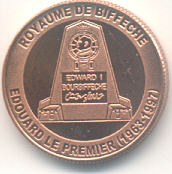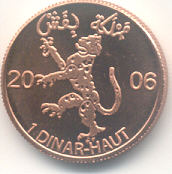 |
 |
| Kingdom of Biffeche | |
 |
|
| According its official Web-site (http://www.kingdomofbiffeche.net/), this tiny Royaume is located on the border between Senegal and Mauritania, on the lower Sénégal River in the “Sahel” region of West Africa. A “place of pristine semi-desert beauty,” it is a short distance (about 25 kilometers) from the picturesque coastal city of Saint-Louis, Sénégal. Though Biffeche “has been a Kingdom from time immemorial,” its origins “are obscure”. It was “first mentioned by the French in early XVII Century documents. An unusual feature of this fundamentally African Kingdom is that” for the last four decades, Biffeche has had foreign/non-African, Caucasian kings. According to other Internet sources, Biffeche (or Bifeche) was the early name for a medium-sized island in the delta of the Senegal River, approximately 2 miles upstream from the island of N'Dar (the site of Saint-Louis). In the 1600s, a chief known as the “Petit Brak” (Little King) ruled over the loosely organized polity of the Biffeche (also referred to as Gangueul); at times, he was subordinate to the “Grand Brak” of the former kingdom of Waalo. | |
| The modern history of Biffeche begins circa 1960, when “life became too hard” and Roman Catholic members of the Sérér-Ndut tribe (it is uncertain as to how long prior to this event their conversion had taken place) were transported to Biffeche from Mont-Roland in central Sénégal. In ancient times, their ancestors inhabited Biffeche and the rest of the Sénégal Valley, but were driven out centuries before by invaders from the north. Tillers of the soil, they settled as part of the Sérér cultures in central Sénégal, especially in the environs known as Mont-Roland west of the city of Thies. The Sérér are the country's oldest native group, “one with a vivid history of Kingdoms and Empires.” As such, it is the Sérér-Ndut who “founded” the royal capital of Biffeche-Ville. Besides them, the other main ethnic groups in this low-lying and largely flat terrain include the Pulaar (also called Fulfulde, Peulh, Peul, Fula); they — the only nomadic pastoralists in all of West Africa — are the largest group in Biffeche), the Wolof (although they are just one of the major indigenous groups in Biffeche, they are the dominant group in Sénégal; their language is gradually becoming the lingua franca of the whole area), the Naar (Moors, who have cultural affinities to the Arabic-speaking groups to the north and east in places like Mauritanie and Mali). These “proud, industrious, fun-loving people with unique cultural practices” all live together harmoniously and are all “truly called ‘the Biffeche’.” After being “resettled”, the Sérér-Ndut “were in desperate straits at first, and nearly starved. They were promised various kinds of support that they didn't get. Their new fields were arid and became salty and barren. The story is that in 1963 they could not settle upon a new King at the time; instead of choosing one of their own people they asked their priest, Father VAST, for guidance. He advised them to choose the person who had helped them the most during their plight.” That individual happened to be American-born Edward Charles Schafer, an active businessman who owned various radio and television stations in St. Louis, Missouri (is the connection between Saint-Loius and St. Louis purely coincidental?). He, a devout Catholic (and “a cousin to both of the Hohenzollern ruling family of Germany and the Hapsburg ruling family of the Austro-Hungarian empire”) was then asked by the “Cardinal of St. Louis to form a committee to aid the needy people of Biffeche.” Schafer, assisted by a Senegalese-Lebanese woman who had immigrated to St. Louis, was indeed able to raise money and send it to the people of Biffeche. At some point, the grateful recipients petitioned Guné Ko Ka Weex Tené, the childless 99th King of Biffeche, to grant them “the boon of requesting that Edward Schafer be proclaimed King of Biffeche.” He agreed. After the Biffeche elders received his permission, they mailed Schafer “some symbolic skins, a packet of holy grains, sacred seeds and a notification in French that he was the King.” Schafer then journeyed to Washington, D.C. for a meeting with G. Mennen Williams, Assistant Secretary of State for African Affairs. The U.S. Department of State, through Williams, apparently presented no objections to Biffeche's new royal arrangement. It was the Sérér-Ndut who arranged for the anointing of King Edward I: in 1963 (“1393 ah in the Islamic calendar”), Schafer was enthroned as the 100th King of Biffeche. Afterwards, “The Americans appeared in Biffeche life”. In addition to the Royal Family, Schafer established a very small, European-style aristocracy in the Kingdom, consisting of local members in Biffeche as well as members in the USA, Great Britain, and Europe (mostly well-to-do patrons who helped the people financially). For instance, “The late Empress Zita of Austria-Hungary addressed” Schafer “royally as ‘Cousin,’ and Prince Charles (of the U.K.) once told him he was envious because it was so much simpler to become King of Biffeche than to wait decades for the throne as Prince of Wales. The Pope gave his Apostolic Blessing to ‘H. M., Edward I.’” Every year, Schafer would hold a Ceremonial Christmas Party at his home, designated by everyone that night as “The Royal Palace”. There, His Majesty would dress regally and receive his court. The American press was purportedly aware of Edward I, and even Esquire Magazine purportedly ran an article about his Kingdom. “For more than 30 years, he diligently helped the people in various ways” (this included seeking the advice of agricultural experts in regards to the Biffeches' farming woes). But Schafer “never visited his Kingdom.” Instead, he issued Royal directives by mail. “He ruled...simply by making his wishes known through correspondence with Pierre Claver Faye, the local native Chef de Village (and later Baron Savoigne) of Biffeche. Edward was completely accepted as King by all the Biffeche people. They were very poor, even by West African standards, and they were proud of having a King so important that he lives in America.” | |
|
By the 1980s, at Biffeche-Ville,
“the fields for rice-growing were unsuccessful; they became salty due to
various causes. The water for irrigation came from the nearby Marigot de
Djeuss, which itself contained some sea-water.” Eventually, the Christian
families moved to a town farther upstream called Savoigne. The Muslim Peulh
took their place at “Old Biffeche City” (renamed Al Madinatoul Islamiah
M'Boubene Peulh), but they did not have better luck with their crops. Though
many administrative functions and festivals are held in Savoigne, the holy
village of M'Boubene (Mboulene and Emboulan are variants) remained the
official capital. Shortly after his reign began, Schafer had come to rely upon another American-born person named Ronnie Reisinger (known as Ronald) of Inneryne. “Related on his mother's side to the old Swedish Royal family, putative heir to Germany's Duchy of Orlemundë, and destined to be Scotland's Baron of Inneryne upon the death of his father, Ronald was one of the few people in America who believed in and understood the problems of monarchy. Over the more than three decades of his rule, Edward I had placed Ronald in more and more areas of trust.” Schafer had no children, and before he died in 1997, “he executed an Act of Succession abdicating the throne and designating Ronald as his successor. Ronald became the 101st King of Biffeche. Unlike Edward, King Ronald immediately visited the Kingdom, along with his 30-year-old son Crown Prince Christopher and a team of interpreters.” But the populace had no idea that Schafer had died until Ronald gave them the sad news; afterwards, he “was apparently welcomed by all. He was accepted as the new King not only by the Christians, but also by the Muslim majority in Savoigne, the Muslim Peulhs in M'Boubene, the Muslim Wolofs, Naar (Moors) and Peulhs of the countryside,” and the traditionalists/animists who still adhere to their age-old spiritual beliefs. After his initial stay, Ronald returned to America. While he was away, the Biffeche people built a monument to receive Schafer's ashes. |
|
 |
 |
 |
 |
|
Biffeche's Web-site
contains some interesting photographic images. One of them shows a
seated Ronald, surrounded by a group of his followers, all of them
wearing T-shirts printed with the slogans “RONALD IS MY KING” on the
front and “BIFFECHE IS MY COUNTRY” on the back. Ronald seems to take his
role (whether his dedication is part-time or full-time) somewhat
seriously. He has donated many thousands of dollars to improve the
primitive infrastructure of Biffeche (the completion of an electric
power line, the purchase of a “motopump”, a new drainage ditch, bridge
repairs). One of his priorities is to combat the tragic salinity problem
of the soil in Biffeche. He has visited officials at all levels of the
Senegalese government to discuss this “ecological disaster”. One of the
obstacles he still faces is “the skepticism that Westerners exhibit
about his ‘Kingship’ whenever he contacts them.”
|
|
| Biffeche is clearly a genuine historical kingdom (according to Mr. Aswan Mamolian, from whom I received an e-mail, “As I have been there many times and personally know several hundred of the more than 40,000 inhabitants of the country I can assure you that it is a real...if very poor...country”), and it truly doesn't appear as if its name has been appropriated by a modern micro-nation of dubious provenance. Currently, the Royaume maintains an American Office in Seminole, Florida and an European Office in Madrid, Spain. Interestingly, there is legally a “personal union” between Biffeche and the Kingdom of Axim in that they share the same King. The King of Biffeche is automatically the King of Axim on the Ghana coast (“This is similar to the current Queen of the U.K. being also Queen of Canada”). “Although the late Bishop Essuah of Sekondi-Tekoradi, Ghana, declared Axim to be ‘a part of Biffeche’ in the 1970's, Axim is not technically administered as a ‘part’ of Biffeche any more than Biffeche is ‘part’ of Axim, and of course neither is a colony of the other. The respective peoples of Axim and Biffeche have always had harmonious relations.” | |
| Monetarily, “The local Biffeche Dinar-Haut (BDH), used only ceremonially, is rarely seen.” This currency, which is actually “not necessary for transacting the commerce within the Kingdom”, has never been “available to the general public”. But recently, two coins have been minted by the Royaume de Biffeche: a copper 1 Dinar-Haut and a brass 5 Dinar-Haut. Both are dated 2006. These pieces were produced by Mr. Jorge Fernández Vidal. He considers this undertaking to be the most important one he has been involved with, “Especially, because this coins will be legal tender and will be used in the actual territory of Biffeche.” Ideally, the plan is to have the Dinar-Haut pegged to the Euro on a one-to-one basis. Mr. Vidal hopes that the coins become popular with collectors around the world, thereby making it possible for him to help Biffeche's people by sharing some of the project's profits with them: “This is more than a business, let say that it's a dream coming true.” | |
| In the end I would like to thank Mr. Eric V. McCrea for the above valuable information compiled brilliantly on the history and background of Biffeche. | |
| Micro-Nations | |
| Chiefa Coins | |